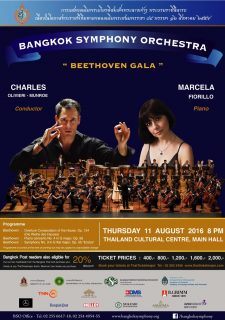A happy meeting of Beethoven and BSO
Source: bangkokpost.com. 18/08/2016. JAMES KELLER
The heavens had opened with an almighty thunderous downpour just a few hours before Ludwig van Beethoven held court for an entire evening at the Thailand Cultural Centre last Thursday, but in fact the Bangkok Symphony Orchestra's dedicated gala celebration of classical music's designated "Creator" was focused -- for the most part -- on the somewhat brighter side of his philosophical worldview.
As conductor Charles Olivieri-Munroe pointed out in his concise and illuminating analytical introductions to each item, the Consecration Of The House overture in C Major Opus 124, Piano Concerto No.4 In G Major Opus 58, and Symphony No.3 In E-flat Major Opus 55 (also known as Eroica) represent a reverse chronological order: 1822, 1806 and 1804. That they all start and finish happily in their respective major modes reminds us that Beethoven was, at heart, an eternal optimist and believer in the basic goodness of the human spirit, in spite of the travails of Earthly existence with which he only too famously grappled.
The cruel injustice of hearing loss before he had written any of this concert's incomparable music, for example. Indeed, the fourth concerto was the last masterpiece Beethoven was able to perform himself. Yet its spellbinding opening phrase for a soloist alone -- as if from a contemplative sonata rather than a grand concerto -- is to be rendered with the lightest of touches before the orchestra transports us swiftly, as if by magic, to an otherworldly tonal space with the most deft of enharmonic shifts.
Pleasingly, the delicacy with which those unassuming opening piano chords must be delivered turned out to be Argentine concert pianist Marcela Fiorillo's starting and finishing point for her whole conception of the concerto. Blessed with such a creative spirit herself, the imaginative tempi which she conjured in the outer two movements certainly kept the whole BSO alert and attentive throughout, not to mention the substantial audience on the edge of their seats.
With a slight physical presence, Fiorillo didn't so much impress with extravagant gestures aimed solely to fill every inch of the 2,000-seat auditorium, but rather she drew the audience beguilingly into her intimate psychological zone by way of a peculiarly understated, yet undeniably magnetic, charm. Consequently, her pianism revealed itself in its best light in the elegiac solitary episodes of the Andante con moto, soft utterances of exquisite introspection which she moulded with a loving tenderness. The string section's strident ritornello-style interjections, which alternated with Fiorillo in this brief essay of repose, displayed rich, sonorous tones. Indeed the BSO played its supportive role admirably for the whole concerto.
The Consecration Of The House overture is by contrast a far more bombastic flurry of Baroque-inspired counterpoint and fugal tapestry. Bassoonist Supakorn Taengnoi delivered a fiendish filigree passage skilfully, while principal trumpet Vanich Potavanich fronted a brass section that revelled and shined in Beethoven's majestic C-major blaze of festive exuberance.
Similarly with the great Eroica symphony itself (except on a far larger canvas, of course), the entire BSO was in fine fettle once again, as the audience was treated to Olivieri-Munroe's robust interpretation of what BBC Music Magazine has this year named the greatest symphony of all time. One-hundred-and-fifty-one conductors worldwide weresurveyed in order to come to this bold assessment, many of whom would have no doubt approved of Olivieri-Munroe's penchant for more-hasty tempi than those of many familiar recordings.
Traditional expectations of occasionally overindulgent rubato, and the often correspondingly laborious unfolding of themes, were swept aside here with an unabashed conviction that Beethoven's own intentions, as regards tempi, were more likely directed by an ever-present imperative of forward momentum.
The first-movement exposition repeat was thankfully observed in order to balance temporally the unprecedented scale of the immense development section at the time of its composition, and a sheer exhilaration was transmitted among the orchestral ranks and to the audience itself as substantial technical challenges -- only heightened by the more urgent pacing -- were met confidently and competently.
Naturally, however optimistic Beethoven may have felt at any particular time during his tumultuous existence, there are always apt to be episodes of turmoil and strife that break through. Indeed, the colossal Marcia Funebre movement which follows surely ranks among the most satisfyingly cathartic outpourings of impassioned melos in the whole of Western music. Principal oboist Damrih Banavitayakit played the heart-wrenching funeral march theme here with the admirable phrasing and tone for which he is known.
The horn section was positively spotlighted in the Trio section of the jovial Scherzo, with Supreeti Ansvananda leading his team here in a clean rendition. Meanwhile the string ranks settled nicely into their hushed spiccato Scherzo motor rhythm, a passage which always proves to be an acid test of fine, controlled restraint.
The same holds true for that most famous of opening themes, which so importantly sets the expectant atmosphere necessary for a successful unfolding of the finale's variations.
The tautness with which the BSO delivered these introductory phrases ensured that the great Eroica's increasingly frenetic orchestration was then able to reveal, step by step and with clarity, the structure's incredible symmetry.
Inevitably reaching an explosive conclusion, this evening proved to be yet another triumph for Bangkok's most treasured classical music institution.

